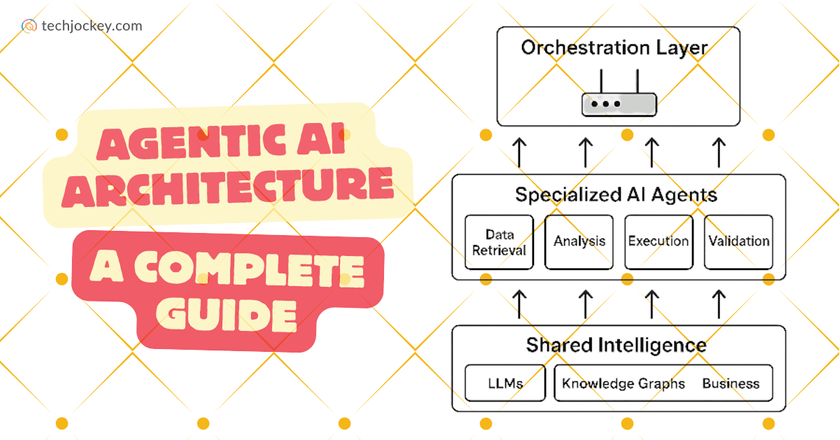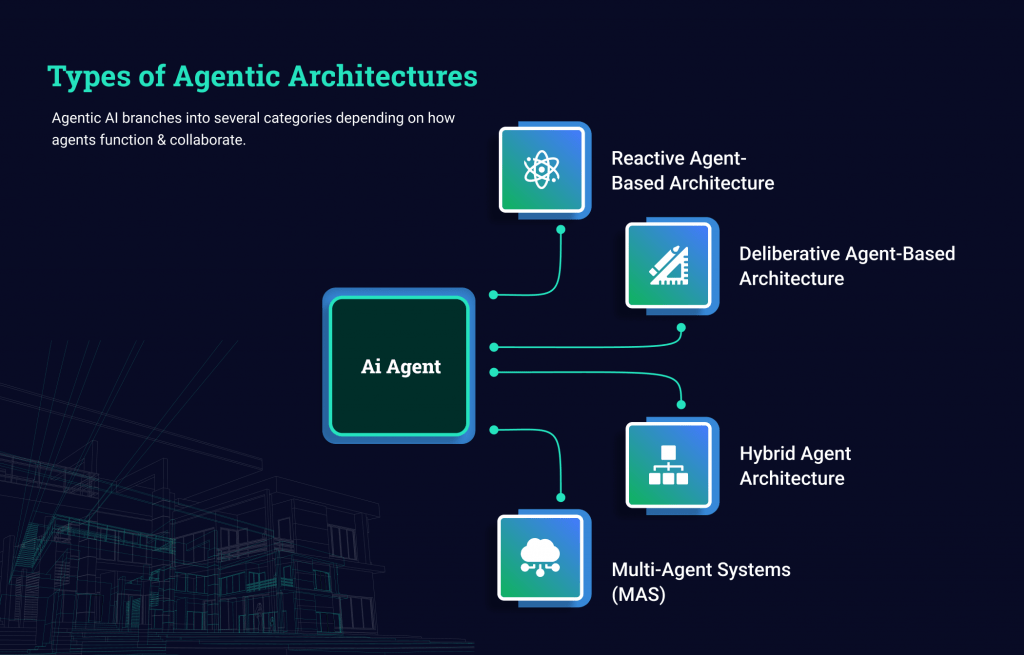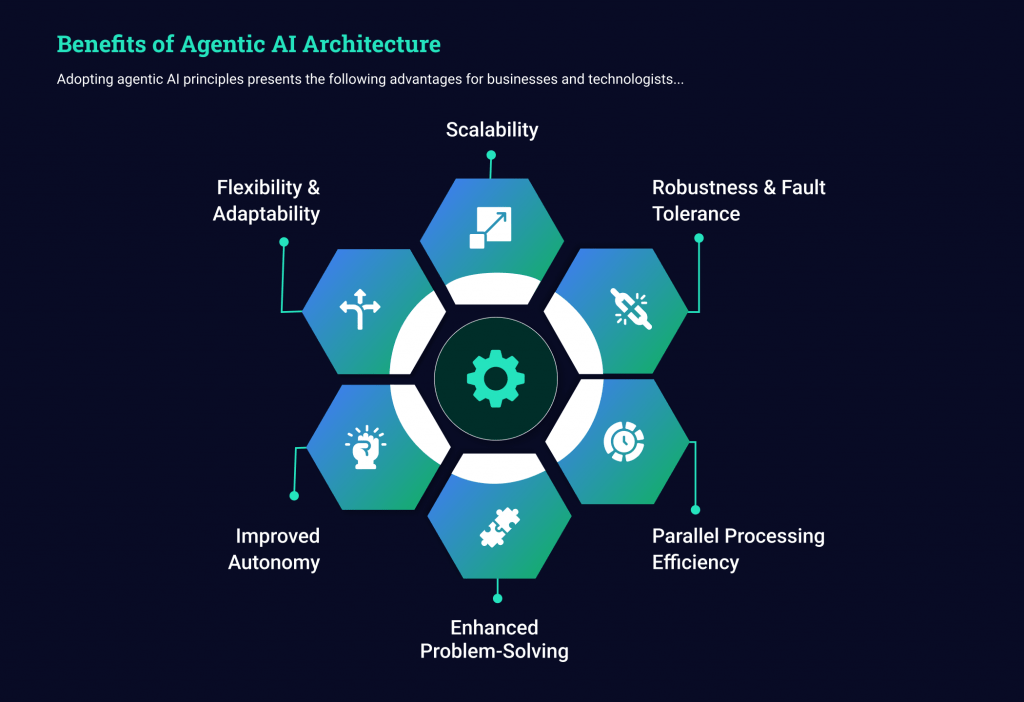Agentic AI Architecture Explained: How AI Systems Think and Act on Their Own ?

AI is advancing at an unimaginable pace. This necessitates a reimagining of how this intelligence is built and how it functions independently. That’s where agentic AI architecture steps in.
It allows AI systems to act with intention, quickly adapt to new environs, and make decisions on their own. This shift isn’t just about technology, it is about changing how we view intelligence itself. Agentic AI brings us closer to systems that understand context and pursue goals with true autonomy. Let’s explore the same further, one key aspect at a time…
What is Agentic AI Architecture?
Agentic AI architecture is a way of designing artificial intelligence systems using independent agents. Each agent wherein works on its own, understands its surroundings, makes decisions, and cooperates with other agents to reach shared goals.
This is akin to how humans make decisions and different from older AI systems that depend on one central system and follow a fixed process. The system, as such, is useful for tasks that need quick thinking and reactions.

Captep
Starting Price
Price on Request
How Does Agentic AI Architecture Work?
Now, let’s understand how agentic AI architecture operates…
- Autonomous Agents: Each agent has goals and skills. They work alone but are designed to help a bigger system goal.
- Environmental Perception: Agents get input from sensors or data, then use it to change their internal state.
- Decision-Making & Planning: Each agent uses AI like rules, learning, or rewards to choose the best action from what it knows.
- Communication: Agents send messages, signals, or info to work together, avoid clashes, or share things.
- Adaptation & Learning: Agents learn from wins and losses, changing their models and plans to get better results over time.
Agentic AI, as such, works best in scenarios that demand decentralized control, flexibility under uncertainty, and handling of multiple objectives simultaneously, making it an advanced form of AI architecture.
Types of Agentic Architectures

Agentic AI is not a one-size-fits-all architecture. It branches into several categories depending on how agents function and collaborate…
- Reactive Agent-Based Architecture: These agents react instantly to input without storing state. Their quick decisions suit tasks needing fast reflexes but not much complex thinking.
- Deliberative Agent-Based Architecture: Deliberative agents create models of their world and plan steps to reach complex goals. This setup allows thinking ahead and smart choices, helping agents act with strategy over long periods.
- Hybrid Agent Architecture: Hybrid systems mix fast-reacting and planning agents, balancing quick actions with smart thinking. They’re common in robots and self-driving cars, where both instant responses and long-term plans are needed.
- Multi-Agent Systems (MAS): MAS has many agents working together in one space. They can help or compete, sharing resources and solving issues. MAS works well for tough tasks like big simulations, smart city control, and distributed AI systems.

MarketingBlocks
Starting Price
$ 27.00
Real-World Applications of Agentic Architecture
Agentic AI is no longer just a theory, it’s actively changing industries by making systems smarter and more autonomous. In customer service, for instance, AI agents manage inquiries on their own. Some agents solve problems, others personalize responses, and some escalate issues to human support when needed.
If we talk about supply chains, these agents handle tasks like order processing, shipping routes, inventory control, and demand forecasting. Each agent represents a part of the system and makes quick decisions to improve overall performance and reduce delays.
In healthcare further, agentic AI helps with patient monitoring, predicting health issues, and creating personalized treatment plans. Agents collect data from patients and alert doctors early, making care more proactive and tailored.
Self-driving cars too make use of agent-based systems to manage navigation, control speed, avoid collisions, and communicate with other vehicles. Each function is handled by a dedicated agent, allowing the vehicle to operate safely and smoothly.
In the realm of cybersecurity, agents constantly monitor networks, detect threats, and respond to attacks faster than traditional systems. Smart cities too make use of agentic AI to coordinate sensors and devices that manage energy use, traffic flow, public safety, and pollution.
These use cases show how agent-based AI helps industries make better decisions and work more efficiently across many areas.
Benefits of Agentic AI Architecture

Adopting agentic AI principles presents the following advantages for businesses and technologists…
- Scalability: The modular design makes it easy to scale the system. You can simply add new agents or improve existing ones without needing to rebuild everything from scratch.
- Robustness & Fault Tolerance: If one agent stops working, the others keep going. This prevents the whole system from failing.
- Flexibility & Adaptability: Agents can learn and adapt on their own as the environment changes. This helps AI systems stay effective over time without needing constant updates.
- Parallel Processing Efficiency: Many agents can work at the same time on different tasks. This speeds up how quickly the system processes information and makes decisions, helping things run more smoothly.
- Improved Autonomy: It reduces the need for human involvement, allowing systems to make faster and more reliable decisions. This is especially useful in complex or risky environments where quick responses are critical.
- Enhanced Problem-Solving: When many agents work together, they come up with different ideas and ways of solving problems. This leads to more creative and complete solutions that consider multiple angles.

Agentic Object Detection
Starting Price
Price on Request
Challenges in Agentic AI Architecture
Despite its strengths, implementing agentic AI architecture presents challenges, such as…
- Complex System Design: Making agents work well together needs careful design and deep knowledge of the field.
- Communication Overhead: Efficient, secure agent communication is vital; too much messaging hurts performance.
- Security Risks: Autonomous agents may be tricked or hacked, causing system-wide risks.
- Ethics & Accountability: The autonomous nature of agents makes it harder to assign responsibility for decisions or mistakes.
- Resource Demands: Running many agents may demand high computational power and energy, creating cost or environmental concerns.
- Standards & Interoperability: Without common standards, agent communication and operation face integration challenges.

MeBeBot
Starting Price
$ 3.50
The Future of Agentic AI Architecture
Agentic AI architecture is expansive with transformative potential driven by ongoing technological advancements…
- Integration with IoT & Edge Computing: As more IoT devices appear, agentic AI systems will help manage and improve large networks of connected things more easily.
- Advances in Learning Algorithms: Better learning methods will help agents act more independently and understand their surroundings more clearly.
- Human-Agent Collaboration: Future AI architectures will team up with humans, helping them think better instead of trying to take their place.
- Standardization & Frameworks: Efforts to build common protocols and software for agent-based AI will make it easier to start and help the system grow.
- Ethical AI & Governance: Responsible AI rules will guide agents, making their choices clear and keeping them accountable.
- Widespread Industry Adoption: From finance to factories, agentic AI will become key tech that helps build faster, smarter, and better business systems.
Conclusion
Agentic AI is a major step forward in artificial intelligence. By using smart, independent agents that can work together, businesses and developers can build more advanced systems. This opens the door to smarter solutions. So, what are you waiting for?
Yashika Aneja is a Senior Content Writer at Techjockey, with over 5 years of experience in content creation and management. From writing about normal everyday affairs to profound fact-based stories on wide-ranging themes, including environment, technology, education, politics, social media, travel, lifestyle so on and so forth, she... Read more


















